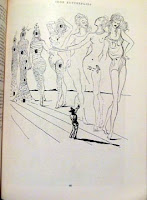by Billy Rose
(Simon and Schuster / Reinhardt & Evans - 1946, 1947, 1948, 1949)
illustrated by Salvador Dali.
This neat little book has 15 original full-page Dali illustrations and a full-page frontispiece, making it a good book for any Dali collector library. In addition, there are numerous smaller illustrations throughout the book.
But, before you rush out to buy a copy, you should know that there are at least three different versions of this book in publication.
The most typical versions are the two American publications, a hardcover and a softcover, both of which are distinguished by a cover designed by Dali. The third, and rarely seen, version is a UK hardcover printing which has a rather generic city scene on the dust jacket clearly not designed by Dali.
In comparing the two American versions, the softcover is a larger format, so the illustrations are a bit larger. In particular, this illustration from the Iron Butterflies chapter is expanded to full-page in the softcover version. This illustration doesn't even appear in the UK version.
The biggest differences occur between the American hardcover and the UK hardcover.
Superficially, the dust jackets are different, and so are the actual covers. The American cover has a gold illustration of a kneeling figure with a rose head, whereas the UK cover is just plain.
Inside the books are even greater differences.
First, the 15 main chapter illustrations of the UK version are all on a salmon-colored background whereas the American version utilizes a number of background colors including blue and yellow.
Second, the UK version has less bleed-through of print from the other side of the page, making the full-page chapter illustrations more ripe for removal and framing.
Third, the UK version is missing many of the smaller b&w illustrations throughout each chapter that are found in the American version. This is especially evident in the chapter header illustrations, which are different for every chapter in the American version, but are just the generic kneeling figure with a rose head in the UK version.
Finally, one chapter illustration in both hardcover versions is colored in the UK version and not colored in the American version. Of course, it is on the salmon-colored background like all the rest of the UK version's full-page illustrations.
All-in-all, I think that either of the two American versions is the better bet for the average Dali collector. Both are readily available for fewer than $15. When buying the hardcover version, make sure you get the cool dust jacket.
As for the UK version, I got mine by accident when I thought I was buying the American hardcover version. I though it was unique, so I decided to keep it. I have never seen another one of these in the years since I got mine. Nevertheless, I doubt it is worth more than the American version, considering its several drawbacks.











4 comments:
I have the hardcover and softcover American editions of WWW, but I also have a hardcover Simon and Schuster edition that doesn't have the wrap-around paper cover, but it is partially affixed to the front and back boards. Also, it comes in a clear slipcase with the title, author's name, and Illustrated by Salvador Dali embossed in gold on the plastic slipcase. Both covers are gold. Any info about this edition?
Is this the "special numbered and autographed edition"? That version has a white hardcover with the dust jacket art (woman with rose-head) printed on it, a gold spine wrap, and is signed by Billy Rose on a page with handwritten number of the edition.
Hello, I recently acquired the British edition. Can anybody tell me what print technology was used in the full page illustrations? They clearly aren't offset prints. I wonder if they are made with a photographic process, hand etched plates, something else?
Hello, I recently acquired the British edition, and I wonder what print technology was used for the full page illustrations. They do not seem to be offset. Are they made by a photographic process, with hand-scribed plates?
Post a Comment